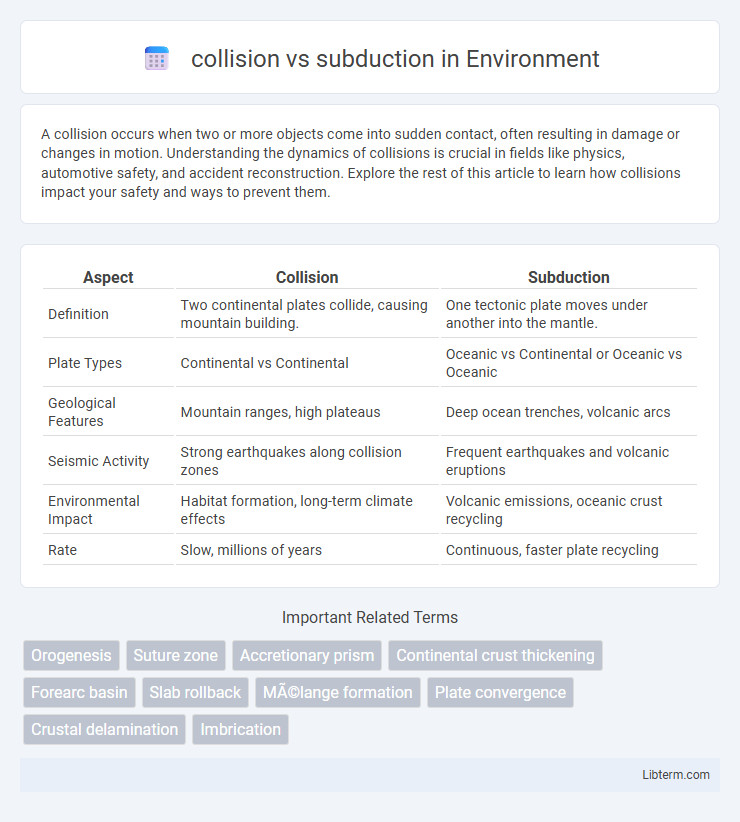A collision occurs when two or more objects come into sudden contact, often resulting in damage or changes in motion. Understanding the dynamics of collisions is crucial in fields like physics, automotive safety, and accident reconstruction. Explore the rest of this article to learn how collisions impact your safety and ways to prevent them.
Table of Comparison
| Aspect | Collision | Subduction |
|---|---|---|
| Definition | Two continental plates collide, causing mountain building. | One tectonic plate moves under another into the mantle. |
| Plate Types | Continental vs Continental | Oceanic vs Continental or Oceanic vs Oceanic |
| Geological Features | Mountain ranges, high plateaus | Deep ocean trenches, volcanic arcs |
| Seismic Activity | Strong earthquakes along collision zones | Frequent earthquakes and volcanic eruptions |
| Environmental Impact | Habitat formation, long-term climate effects | Volcanic emissions, oceanic crust recycling |
| Rate | Slow, millions of years | Continuous, faster plate recycling |
Introduction to Plate Tectonics
Collision zones form where two continental plates converge, creating mountain ranges like the Himalayas due to crustal thickening and intense deformation. Subduction zones occur when an oceanic plate sinks beneath a continental or another oceanic plate, generating volcanic arcs and deep ocean trenches as seen in the Pacific Ring of Fire. Plate tectonics explains these processes by describing the movement and interaction of Earth's lithospheric plates driven by mantle convection.
Defining Collision and Subduction
Collision occurs when two tectonic plates of similar density converge, causing the crust to buckle and form mountain ranges without significant sinking. Subduction involves a denser oceanic plate descending beneath a lighter continental or oceanic plate into the mantle, leading to volcanic activity and deep ocean trenches. Both processes are essential mechanisms in plate tectonics, shaping Earth's surface through crustal deformation and recycling.
Key Differences Between Collision and Subduction
Collision involves two continental plates converging, resulting in mountain building and crustal thickening, while subduction occurs when an oceanic plate sinks beneath a continental or oceanic plate, leading to volcanic activity and trench formation. Collision zones produce large fold mountains like the Himalayas, whereas subduction zones generate volcanic arcs such as the Pacific Ring of Fire. The key differences lie in the types of plates involved, surface features created, and associated geological processes like crust recycling in subduction but crust accumulation in collision settings.
Geological Processes Involved
Collision involves the convergent movement of two continental plates, resulting in intense crustal deformation, mountain building, and thickening due to the compression and folding of sedimentary layers. Subduction occurs when an oceanic plate descends beneath a continental or another oceanic plate, leading to partial melting, volcanic arc formation, and trench development through the process of mantle wedge hydration and slab rollback. Both geological processes drive tectonic activity but differ fundamentally in the crustal dynamics and resulting topographical features formed.
Tectonic Features Formed by Collision
Collision zones create prominent tectonic features such as extensive mountain ranges, thickened crust, and complex fold-and-thrust belts due to the convergence and compression of continental plates. Unlike subduction zones, where one plate sinks beneath another, collision zones result in crustal shortening and uplift, forming high plateaus and extensive metamorphic belts. Examples include the Himalayas and the Alps, where intense deformation and crustal thickening are primary geological characteristics.
Landforms Resulting from Subduction
Subduction zones create distinctive landforms such as deep ocean trenches, volcanic arcs, and accretionary wedges due to one tectonic plate sinking beneath another. Volcanic arcs form from magma generated by the melting of the subducted plate, resulting in chains of volcanoes parallel to the trench. Accretionary wedges develop from sediments scraped off the descending plate, building complex mountain belts and coastal ranges.
Major Examples of Collision Zones
The Himalayas and the Alps serve as major examples of collision zones formed by the convergence of continental plates, where intense mountain-building processes occur due to the collision of the Indian and Eurasian plates and the African and Eurasian plates, respectively. These zones are characterized by the absence of subduction, leading to crustal thickening and high seismic activity as opposed to subduction zones like the Pacific Ring of Fire where oceanic plates descend beneath continental plates. Understanding these collision zones helps explain the formation of some of the world's tallest mountain ranges and their associated geodynamic phenomena.
Significant Subduction Zones Worldwide
Significant subduction zones worldwide, such as the Pacific Ring of Fire, the Mariana Trench, and the Andes Mountain Range, are regions where one tectonic plate is forced beneath another, generating intense seismic activity and volcanic eruptions. Collision zones differ as they involve the convergence of two continental plates causing mountain formation without subduction, like the Himalayas. Subduction zones play a critical role in recycling oceanic crust and shaping Earth's topography through deep ocean trenches, volcanic arcs, and frequent earthquakes.
Environmental and Geohazard Implications
Collision zones generate significant seismic activity and mountain building, leading to landslides and river damming that can disrupt ecosystems and human settlements. Subduction zones produce deep earthquakes and volcanic eruptions, triggering tsunamis and acid rain that pose severe risks to coastal communities and marine life. Both tectonic processes influence long-term soil formation and groundwater circulation, affecting local agriculture and water resources.
Future Research and Emerging Insights
Future research in collision versus subduction zones emphasizes advanced geophysical imaging techniques to unravel complex earthquake dynamics and mantle convection patterns. Emerging insights highlight the role of fluid dynamics in weakening subduction interfaces and the identification of novel biomarkers for detecting early-stage collision-related crustal deformation. These developments aim to refine predictive models of seismic hazards and improve resource exploration in convergent tectonic settings.
collision Infographic

 libterm.com
libterm.com